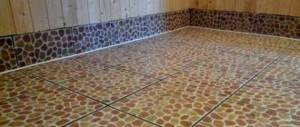Contrary to the popular belief among many women that tow is a bad hairstyle on their pretty heads, in fact it is a material necessary in construction and plumbing work. Shipbuilding enterprises and organizations involved in the laying and subsequent maintenance of pipelines and cables will also not be able to do without it. As you can see, tow is a substance that is in great demand in many highly specialized industries. But every man can easily find in his pantry a small piece of fibrous material that is hard to the touch.
Why do you need to caulk a bathhouse?
Craftsmen usually answer such a question simply - so that the log house does not rot or fall apart. Without a seal, a log box becomes a cold, eternally creaking hut. If you do not caulk the bathhouse and seal the seams hermetically, then the supporting surfaces of the crowns will rot in a year or two and the log house will simply “sit down” or fall on its side to the north.
In addition to choosing how to caulk a log bathhouse, it is important to do the job correctly, so we will try to understand the means, tools and rules for caulking a bathhouse.
For high-quality seam sealing you will need:
- Packaging jute, flax tow, proven over the years, or any other type of sealant with a fiber structure;
- A set of tools - a wooden hammer, a spatula, a wedge knife and a hook for stripping a seam or an electric groove;
- Brush with stiff bristles;
- Carpentry measurer.
Advice!
There are few tools, but they will all be needed for the job. The first time you can rent them. After your first practical experience, it will become clear how to properly caulk a bathhouse, then you can buy a good kit or make it yourself. If you want to seal the seams with sealant, fortunately there are quite a lot of different brands and types of them sold for bathhouse needs, then in this case no tool other than a nozzle gun for a tube with liquid polymer will be needed at all. It is possible and necessary to spray the joints with sealant for a log bathhouse in one day; the technology requires laying the paste-like mass in two passes with a difference of no more than four hours. Any disruption of the process can lead to peeling of the sealant, whereas caulking the frame of a bathhouse can be done in a couple of days with interruptions.
Review of sanitary flax
Linen is a popular material for winding. The outdated name is tow. Linen is an environmentally friendly material that does not pose any harm to human health. The product does not require certification, therefore, it is possible to seal drinking water pipes.
The additional material that is also needed for impregnating sanitary tow is environmentally friendly. Thanks to impregnation, this material will last for a fairly long period of time. Linen is a publicly available product. The product is sold in absolutely any plumbing store, so finding it will not be difficult.
Let's consider the advantages and disadvantages of this material in detail.
Benefits of flax
Pros of this product:
- Low cost. Tow has the smallest price tag in comparison with other windings. Therefore, when purchasing, it is better to pay attention to the quality of sanitary tow. If flax is sold in the form of a braid, then it is a quality material. If it is in the form of a tight coil, then this indicates low quality.
- Versatility in use. Can be used for any type of connection if winding is carried out correctly.
- During swelling, the volume of the winding becomes larger. This means that if the connection starts to leak, the material will immediately close everything. Small leaks will be closed.
- Resistance to mechanical stress. Only flax allows you to orient plumbing fixtures more accurately. You can make one revolution back without losing the tightness.
Disadvantages of flax
There are also disadvantages:
- In addition to tow, it is necessary to use other means, for example, grease, sealing paste, silicone and other products. If flax is an organic material, then it can rot due to the influence of water and air. Air gets in during repairs or maintenance, which must be carried out every year. And the listed products can interfere with this process.
- It is necessary to carry out preliminary preparation of the thread. Most manufacturers who produce fittings make already prepared threads for plumbing tow. It has notches. If they are missing, then they must be created. This can be done using pliers, a file or a hacksaw. They are necessary so that the plumbing material cannot slide along the coils.
- If the connections are made of brass or bronze, then during winding it is necessary to carry out the work carefully and carefully. If you apply a thick layer of winding to such connections, defects will appear on the threads. It may even happen that the thread breaks.
- Strict rules must be followed when winding this organic material. In addition to the thread, you need to first prepare the plumbing material itself. It is necessary to impregnate it with some substance to prevent future rotting. Winding must be carried out observing the direction. Winds against twisting. The ends of the flax must be brought beyond the boundaries of the thread, then they should be tightened. Hold with your finger and twist.
- It is also worth noting that the additional materials indicated above do not prevent the destruction of the connection. If you use silicone to glue different connection elements, then it will be extremely difficult and even impossible to separate them later. If flax is used without the use of additional materials, then rust appears on the winding, which will transfer to the steel.
Comparison with FUM tape
Sealing involves sealing the water pipe. If it is necessary to seal cold water pipes, then in this case flax and tape are equally suitable. You just need to wind it correctly. But if it is necessary to seal pipes made of plastic or metal-plastic, then it is better to choose FUM tape.
The main advantage is that using tape the work will go much faster, since installation is quite easy. Also, the threads of the fittings are smooth, so the use of plumbing tape will be much more effective.
However, fum tape loses its effectiveness if it is necessary to seal a pipe whose diameter is more than 20 millimeters. For pipes with this diameter, flax should be used.
Choosing material for padding
Traditionally, seams and joints between wooden parts are sealed with a moisture-resistant, durable and necessarily easily deformable material. Interventional insulation for a bath can be made from:
- Synthetic polypropylene fibers, for example, in the form of a tape of woven and non-woven structure;
- Organic fiber, primarily jute cords and flax tow;
- Natural plant fibers from certain types of moss for baths.
For your information! Sometimes the problem arises of choosing whether moss or jute is better for a bathhouse, or they try to determine before starting work whether it is better to caulk with synthetics or organics. You need to choose based on the degree of shrinkage of the bathhouse frame and the size of the seam between the crowns.
What is better, moss or tow for a bath?
Today, both materials are recognized as the most durable and reliable of all traditional fiber seals. In both cases, the decisive factor is not even the type, but the quality of the preparation of the material.
Moss is recognized by all craftsmen as a universal means for sealing crowns. Most often they try to caulk the bathhouse with red or white moss. Bunches of plants are prepared 2-3 weeks before the start of work. Before caulking the bathhouse, remove debris and dry the moss under a canopy, periodically turning over and shaking the layers.
The organic matter should remain slightly moist. After drying, the fibers turn into a springy and strong wire-like structure.
Caulking walls with moss is not difficult; you just need to correctly measure the amount of material and the force of hitting the shovel with a hammer. The easiest way is to caulk the seams immediately on the new log house, after assembling the walls of the bathhouse. After shrinkage, after a year and a half, the procedure will have to be repeated with the same material.
For your information! Often, craftsmen who undertake to caulk the walls of a bathhouse tell stories about the bactericidal properties of mosses, the ability of the plant to germinate and completely fill the gap between the crowns.
In fact, the seal can bloom and turn green only if the birds have collected seeds and grass in the spring. If you caulk with organic matter, the seal can easily become a source of problems, from the appearance of fungus to green sprouts. Therefore, you still need to be able to prepare the moss for the bathhouse for caulking. If it’s too dry, the material becomes brittle and doesn’t hold well in the gap; too wet moss is very difficult to caulk into the seam.
Plumbing tow: technical characteristics, winding on thread
Some people ask: what is best for sealing threads, fluoroplastic sealing material (FUM tape) or plumbing tow? This dispute has been going on for a long time, because it is impossible to give an exact answer.
For each specific type of procedure, its own material is suitable. And each product can be an excellent alternative to another. But the goal is the same - to make the connection airtight. Therefore, let's look at plumbing tow, its technical characteristics, as well as the process of winding it.
How difficult is it to caulk the walls of a bathhouse with tow?
Tow or combed flax fibers twisted into bundles are safer than moss or jute. Due to its soft and thin structure, working with linen material is more difficult than with any other sealants. Tow is convenient for caulking the seams on the walls of a rounded bathhouse. Interventional gaps on log buildings are too large, so the fiber has to be folded into several loops. Technologically, this does not affect the quality, but it can seriously delay the caulking process over time.
Flax tow, thanks to the small amount of non-drying oils remaining in the fabrics, has the best damping properties of all possible sealants, both natural and synthetic. Tow for a bath is very well suited for sealing corner locks, especially hand-cut ones. When shrinking, the bathhouse log does not make frightening creaks and sounds; the process itself occurs without any complications.
The only drawback is the low durability of flax fiber. In a log house, tow caulk will last up to 5 years; in a bathhouse, the fiber burns out in 2-3 years.
Tow and plumbing how it works
When choosing FUM tape or flax strands for thread sealing, it is wise to consider the third option - modern and more convenient. However, if in practice the question has become tough - which is better, fum tape or tow - then the answer will depend on several factors: what thread is sealed, in what system, where, what is its feature. Let's talk today about the advantages and disadvantages of these classic sealants and analyze their scope of application.
Tow and plumbing - how it works
Plumbing flax, tow, flax strands are all names for the same thing. Tow flax is a sealant used for household needs for more than 50 years. They compacted flax in the USSR, and they do it in the new Russia as well. Flax was not affected by any cataclysms: the transition to a market economy, the appearance of metal-plastic on the market, the demand for innovative sealants. Perhaps it will survive flax and renovation.
There is an opinion among ordinary people that the sealing of threads on linen, if not last century, certainly smells of mothballs. There were cases when, upon seeing tow in the hands of a master, customers widened their eyes and advised not to do this again. They say there are better materials in stores. However, professionals know that they need to work with any sealant, because the need for it may arise unexpectedly.
Linen is a skein in the form of a braid, from which the required length is cut to seal the thread of a specific diameter. It is difficult to calculate the exact amount of flax for the mixture. They do this by eye, based on previous experience. We can say for sure that linen is suitable for carving in any condition: dirty, wet or old. Those. For systems that have seen the world, for example, in old houses, linen is irreplaceable.
Tow for pipes is also popular due to its low price. The cost of 100 grams of sanitary flax starts at 50 rubles and depends on the quality of the material. However, not all so simple. By itself, a strand of flax is useless. You can't just wind flax and assemble the joint. Additional impregnation is required to enhance the sealing properties. Impregnation paste is applied on top of the flax wound on the thread and protects against corrosion, swelling, and rotting. Together with impregnation, the price of flax has already reached 150 rubles per 100 grams.
The usual form of flax production - in braids - causes complaints from consumers. Flax fibers get in the way, cling to clothes, stick to the impregnation and spoil the appearance of the joint. Some manufacturers today produce flax in a bobbin. A reel costs more than 200 rubles for 80-100 grams. Which, of course, reduces talk about the availability of flax to nothing.
The two main disadvantages of flax are its nature and application technology. Flax is organic, plant material. And how plant material rots or decays over time. Impregnated tow lasts longer than the one without treatment, but still the compound on flax has a very specific and very short shelf life - 3-5 years. Such connections should be regularly inspected and checked for leaks.
When it comes to application, linen requires a trained hand and experience. First, the difficulty lies in the exact amount of linen tape. Secondly, they wind it strictly along the thread, getting into each turn. Thirdly, the end of the strand is also secured in a special way at the beginning of the thread - so that when twisted it does not roll or slip. To secure flax to the threads, notches are specially made or fittings with ready-made, factory-made notches are chosen. It is not recommended to use flax on plastic, metal-plastic, or thin-walled threads. In general, with a wide variety of sealants on the market, the use of flax raises a lot of questions.
What can be used instead of tow? Synthetic sealants. They last longer and are less hassle. Let's look at an example of such a sealant - FUM tape.
Alternative or not?
FUM tape is a synthetic sealant based on fluoroplastic. As the name implies, it is a tape produced in a reel. The cost varies from 30 to 160 rubles and above and depends on the quality of the material, width and thickness. To seal the thread, the FUM is selected individually, depending on the diameter.
FUM tape, unlike flax, is most effective on plastic pipes and small threads. Many craftsmen note that they use FUM for diameters no larger than 1 inch, because... Otherwise, tape consumption cannot be called economical.
To apply FUM tape, it is first stretched into a thread, wound onto each thread several times, and then the entire width of the tape is applied to the thread and secured. They begin to assemble the connection and do it very carefully so that the tape does not get lost or break. If you have never had to deal with this kind of sealant before, we advise you to practice “idle” - try the winding a couple of times, and then get to work. By the way, this way you will quickly understand how to replace tow with ribbon or some other material.
Jute fiber
Mechanically combed stems of jute hemp Jute Tassa produce a tough and at the same time durable fiber, which is used not only as a sealant on the walls of the bathhouse, it is an ideal material for containers and technical fabrics. Jute is produced in the form of coils, ribbons, and ropes, which allows you to caulk cracks on the walls of a bathhouse many times faster than using tow and moss.
Technical jute has only two disadvantages:
- High hygroscopicity;
- Susceptibility to rotting when soaked for a long time.
Jute for a bathhouse is interesting because during the shrinkage process it ideally fills the inter-crown space, especially if the log house is built from chopped logs. In this case, you only need to caulk with jute fiber and rope.
If, according to the project, the bathhouse building is planned to be covered with decorative finishing, the jute rope will simply rot in a couple of years. The tapes are laid to seal the crowns of the new log house; the rope is good for finishing the open surfaces of the walls of the bathhouse.
In fact, jute occupies an intermediate position between dense and hard moss and soft flax tow.
Tow in rolls
Tow made of jute and flax is sold in rolls and consists of jute strips; this material is often used in construction and plumbing. Rolls have a standard width, usually 1.6 meters, and companies selling such products usually offer to cut roll insulation into strips of the required width. Tow in rolls, consisting of tape, is perfect for sealing various doorways and window openings; this material has a stable density and thickness. Insulation in rolls has a number of unique advantages, which determine its scope of use. Tow in rolls is sold at affordable prices and is a high-quality and economical natural material that has a wide range of applications in construction and others.
Synthetic materials
In addition to natural fibers, you can caulk a bathhouse with more modern materials, for example, a composite cord consisting half of polypropylene threads and wool fibers. This type of caulking ensures strong retention of the seal even when the gap expands.
Caulking with synthetics is much more difficult; in addition, polypropylene burns out and crumbles under the influence of ultraviolet radiation, so for a bath it is best to use seals made of natural materials.
Seam filling technology
The process itself looks easy. In theory, it is necessary to caulk the crowns of a successfully constructed bathhouse twice, immediately after construction and upon completion of the shrinkage processes. In practice, caulking is done every three years, especially if the log has not been sanded and rounded.
First of all, before caulking the bathhouse, you need to inspect the seams, check and free the joint line from the old burnt-out seal. If the gaps in the inter-crown space of the bathhouse are supposed to be caulked with a cord or rope, then you will first need to measure the maximum drawdown of the crowns with a gauge.
This is done in order to determine the uniformity of shrinkage of the bathhouse building. If on one side the seal is pinched and compressed, and on the other it has fallen out of the cracks, then before caulking the box you need to determine the reasons for the uneven settling of the log house. At the same time, we specify the required thickness of the jute or flax hemp rope.
Preparatory stage
Before winding flax or tow on the thread, you need to prepare the joint surface and determine the required amount of tow. Screw the fitting onto the thread as is, without wrapping anything. This will help determine how much tow you will need to take.
If the thread is smooth and even (in the case of factory threading, most likely this will be the case), it is recommended to apply notches on the threads for better adhesion. For this, a water wrench, a triangular socket or regular pliers are suitable; all you need to do is apply notches across the thread, without being too zealous. This is done in order to prevent the tow from sliding along the threads.
The notches should not be too deep; you do not need to literally pierce the metal (watch the video). The reliability of the connection in the future will depend on how the tow is wound correctly. If you put too little and rarely, it will leak, but too much can be much more dangerous - a wound area that is wrapped too tightly can burst when the temperature rises (as you know, metal expands when heated).
Sealing the material with tape
The easiest way to caulk a bathhouse is with a tape seal. After measuring the cracks, it becomes clear what width of tape should be used in this section of the log house. One end of the roll is secured in the gap at the corner, the sealing strip is carefully unrolled along the wall without twisting, a margin of 20-25 cm is left and cut off.
The ribbon laid out on the gap is carefully tucked into the gap so that the material does not sag or be stretched. Caulking begins from the widest edge, using a hammer and a wooden spatula with a rubber tip. The ribbon is pressed into the slot with light blows. It will be necessary to make 3-4 passes so that the sealant evenly and completely fits end-to-end between the crowns.
It will be necessary to caulk three or four pieces of tape before the desired joint seal can be achieved.
For your information! In this way, the cracks along the entire perimeter of the crown are sealed before it is possible to move to the next higher level.
If you caulk the entire wall at once, then one edge of the log house may rise by more than the thickness of the log, which will lead to the breakage of the upper rows of the bathhouse.
Let's start winding
A small amount of tow should be taken from the total bunch, and the fibers should be even, smooth, without knots or breaks.
The tow needs to be twisted into a rope of such thickness that it (thickness) is equal to the pitch of the thread, that is, it fills the cavity between the turns.
Winding is carried out from the inner edge of the thread;
There are several ways to wind tow - for example, some advise starting winding with an indentation and then overlapping the fibers so that they hold better (see video).
But for beginners it will be easier to wind directly from the edge.
So, by attaching the end of the linen rope to the first turn, we wind in the direction opposite to the twisting direction - that is, clockwise if the thread is right-handed (in the vast majority of cases this is the case).
You need to wrap it tightly, but not too much - two layers will be more than enough. As soon as you have wound the tow on the thread, you should, without letting go of your fingers, apply the paste to fix it. Silicone, paint or glue are often used for this, but from personal experience we recommend paying attention to “Unipak” - this paste is more neutral with respect to metal and has no taste or smell, which will help avoid problems when installing water pipes.
Caulk joints of tow
The procedure for sealing the inter-crown space with bundles of fibers, such as tow or linen yarn, is a little more complicated. After cleaning the seam between the logs, the future place where the tow will be laid is rubbed with a mixture of formaldehyde, alcohol and linseed oil. You can impregnate individual cords with a disinfectant mixture before laying them in the wall of the bathhouse.
You need to caulk the bathhouse wall in the same sequence as when using tape. If the thickness of the seam is small, then the material can be laid by immediately rolling cords of 2-3 mm thick from the fiber. A tightly rolled roll of tow applied to the gap, without blows, is carefully pressed into the gap with a spatula.
For the next pass, roll up a thicker cord from tow, about 3-4 mm; this time you need to caulk the seam with force. For the last pass, a thick rope is rolled up, sometimes up to 8 mm. The material is hammered into the gap so that the edge protrudes above the line of the bathhouse crowns by no more than 3-4 mm.
If there are wide cavities between the crowns, they are caulked with additional ropes made of tow with a lubricant of any rubber-based elastic adhesive. In the same way, cracks in the logs of the bathhouse walls are clogged. The repaired areas are rubbed with additional acrylic paste.
Tow in bales
Thanks to jute tow in bales, the level of thermal protection of a wooden structure significantly increases. This type of insulation in bales is used to seal and insulate common roof joints in a wooden house. This material is sold today compressed into special bales of 70 kg; the insulation consists of short matted fibers of flax and jute, which give unique characteristics. Bale insulation has minor differences from simple jute tow and from tape; they all have their own advantages and special characteristics. The price of tow in bales is quite reasonable; it is packed in pressed bales and tied with 8 mm thick rope. Previously, only jute tapes were used for wooden houses, but today tow in bales is used for this purpose.











